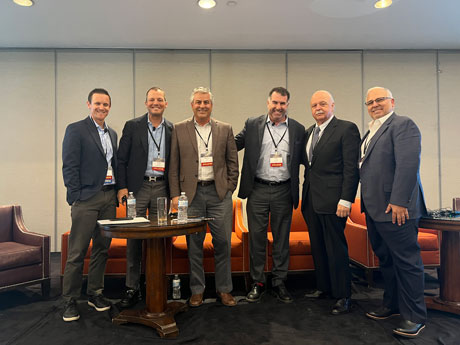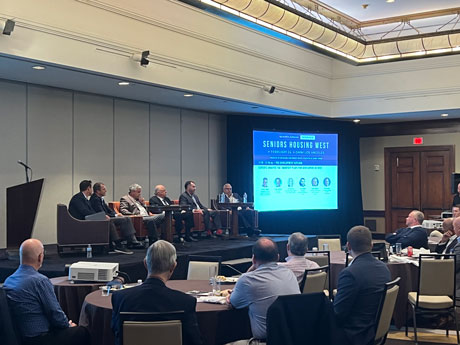LOS ANGELES — While the COVID-19 pandemic clearly had a negative effect on seniors housing for the short term, it also provided a chance for developers, owners and operators to take an introspective look at what the industry does well and what needs improvement.
“Many of us were on this stage two years ago talking about this same topic of development,” said Ben Seager, associate principal at KTGY, while moderating a panel at InterFace Seniors Housing West in Los Angeles. “A lot of people had opinions that probably got turned upside down due to the pandemic.”
Seager’s comments came during a panel titled “The Development Outlook: Experts Analyze the Smartest Plays for Developers in 2022” at the event, which took place in Los Angeles on Feb. 24. The other panelists included Marco Vakili, managing director of Northern California, Alliance Residential; Chip Gabriel, president, Generations LLC; MJ Ritschel, chief investment officer, Kisco Senior Living; Paul Mullin, principal, Flatiron Development Group; and Frank Haffner, founder and chairman, Monarch Senior Living.
One silver lining of the pandemic is that important improvements that were rare before are now included in development plans regularly, said Mullin. These include improved air filtration systems, biophilic elements like plant-filled “green walls” and improved lighting.
“All these things we’ve thought about before are now being implemented, particularly on the HVAC or mechanical side of things. I’m seeing people spend the money to put those in and have a marketing differentiator and a healthier community.”
Vakili noted that there has become a clearer distinction between levels of care, as well. This is partially due to the continued expansion of the active adult sector, allowing independent living units to absorb higher acuity residents while active adult takes the seniors who are still active and fit.
“Over the past two years, this thing we called independent living for a long time is bifurcating along two areas: Independent living light and active adult.”

Panelists included, from left, moderator Ben Seager, associate principal, KTGY; Chip Gabriel, president, Generations LLC; Marco Vakili, managing director, Northern California, Alliance Residential; Frank Haffner, founder and chairman, Monarch Senior Living; Paul Mullin, principal, Flatiron Development Group; and MJ Ritschel, chief investment officer, Kisco Senior Living.
Of course, developers faced significant challenges due to the pandemic. On the negative side, Gabriel noted that “everything seems to take a longer time,” from entitlements to construction to lease-up.
For Monarch’s part, Haffner said the company “hit the pause button on development in February 2020.” However, as hospitals filled up and couldn’t take in new patients, they began to recognize the ability of seniors housing to take the load off of emergency rooms and intensive-care units.
“Medical authorities and hospitals now recognize us now as a vital part of that supply chain,” said Haffner. “That lets us deal with people on a lower cost system that is more beneficial, so the families like it better, too. That accelerated the integration of how we view ourselves as a residential model and how we take care of people as they reach higher levels of acuity.”
Ritschel agreed, noting that the infection-control measures showcased how safe seniors housing communities are for residents compared to living at home and having to interact with the general population.
“It highlighted that senior living is a very safe place to live. This is a very special business. We’re serving the most vulnerable in our population. As an industry we’ve grown up a lot. We’ve evolved out of the pandemic. Hopefully we’ll be looking in the rear-view mirror pretty shortly.”
Mullin added that those companies that never slowed down their development plans are now poised to succeed, as new supply lags behind mounting demand.
“I’m excited to see the folks that ran into the pandemic full speed on development and didn’t look back. They doubled down during the pandemic, and I think folks like that are going to reap huge rewards. There was a slowdown and there will be a lack of supply, especially for memory care, the next five to 10 years.”
— Jeff Shaw

